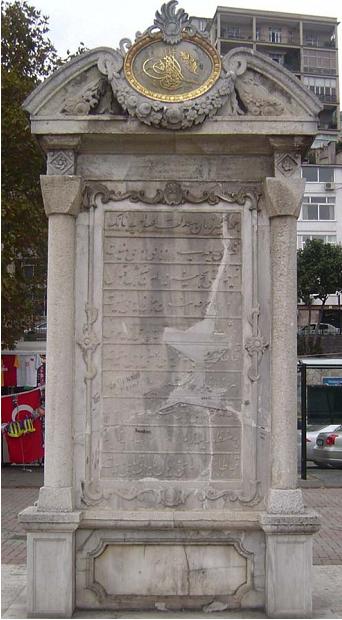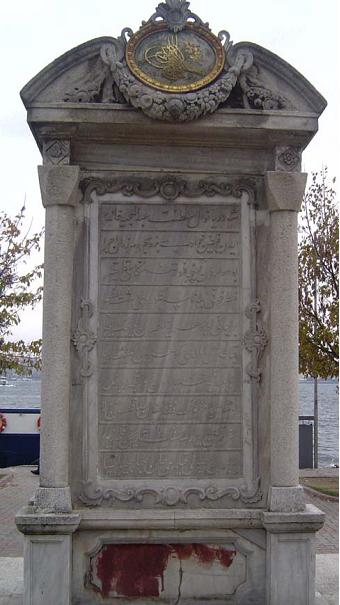We are glad that the monument is still in very good conditions after 12 years when it was discovered in 1994. To my surprise the relocation has indicated that there is also some inscription on the back of this monument. The full size pictures of the monument with front side and back sides are shown as follows. Calligraphic writing at the top with gold is BISM-ALLAH (Starting in the Name of Allah).
CONTINUATION OF RESEARCH
Our research for deciphering the inscription and to find out the background history of this monument is going on. Here is an update on the discovery of monument of Guru Nanak:UPDATING
Our initial research after consulting a number of scholars indicates that there is a need for hard and serious efforts to work with scholars not only experts in Arabic and Persian but also in Turkish, and who are familiar with the status of these languages of that time. However, we have discovered through the help of scholars from Montreal and Istanbul in coordination with Mr. T. Sibia the following:First Deciphering Attempt
I found the importance of the monument only when Mr. Iqbal Kaiser, the author of a book, ‘Sikh Shrines in Pakistan’, and Mr. Syed Afzal Haider, Senior Advocate of Supreme Court of Pakistan, and the author of a book, ‘Baba Nanak’, helped me to decipher the first line of the inscription, which is in Arabic/Persian/Turkish language (Fig. 1. Front view). It clearly indicates that it is dedicated to Guru Nanak. The first line deciphered by them is as follows:In Arabic/Persian/Turkish languages (Transliterated in Gurmukhi Script):
ਜਹਾਂਗੀਰ ਜਮਾਂ ਹਿੰਦ ਲਤ ਅਬਦ ਅਲ ਮਾਜੀਦ ਨਾਨਕ । (Jehangir jaman hind lat abd al majid Nanak.)
Meanings in Punjabi:
ਜਮਾਨੇ ਦਾ ਮਾਲਕ, ਹਿੰਦ ਦਾ ਬੰਦਾ, ਰੱਬ ਦਾ ਨਾਨਕ । (jamanay da malik, hind da banda, rab da Nanak)
Meanings in English:
The Lord of the time, resident of India, Nanak – the man of God.
The rest of the long inscription is not legible and is still to be deciphered. However, the date, 1267 Hijri (1850 CE), in the crown and at the bottom line of the monument is quite legible.
When we examined the inscription on the other side of the monument (Fig. 2. Back side) it appears that the inscription was engraved either in 1217 or 1267 Hijri, which is equivalent to 1802 or 1850 CE. The later date (1850 CE) appears to be correct since the Emperor of the Ottoman Empire (1839-61 CE) was Abd-al-Majid (1823-61 CE).
It is also assumed that the name of the inscriber is also Abd-al-Majid, which appears above that date. Abd-al-Majid is a very common name among Muslims. And ‘Abd-al-Majid’ is also written before ‘Nanak’ at the end of the first line on the front side of the monument. Then ‘Abd-al-Majid’ is also appearing at the end of the first line on the back side of the monument. Now the question is:
Who is ‘Abd-al-Majid Nanak’?
Who is this ‘Nanak’ in the inscription on monument discovered in Istanbul?
Further study on its history indicates that this monument was built in the name of Ottoman Empire Sultan Abd-al-Majid in 1267 Hijri (1850 CE). A port was established in that area (Kabata) in order to save the boats of Sultan from heavy winds and this stone monument was put there at that time. On back side of the monument the benefits of the port are written and on front side facing the Straits of Bosporus there is prayer for the Sultan. If it is so then: Is this prayer connected to Guru Nanak?
The place of the monument was changed from it's original place when there was road construction and on 1987-1988 it was restored by government, now it is located in the same area which is called Kabata (near dolmabahçe palace)
At present it seems that until the whole inscription on both sides of the monument is deciphered it is difficult to draw any inference to relate it to Guru Nanak.
Since the date (1850) on the monument indicates that it was constructed more than 300 years after Guru Nanak (1469-1539 CE), it creates another curiosity as to why someone would erect a monument with an inscription containing the name of Guru Nanak well after his passing?
Serious research is also needed to look into the history of Sufism in the Middle East and any interaction with Sufism in India since in the Muslim world Nanak is recorded as a Sufi named ‘Baba Nanak’, Baba Nanak Fakir, and even as ‘Hazrat Rab Majid Baba Nanak Faqir’ on the stone at Baghdad.
Besides a new line of research, “To study the interaction of the philosophy of Guru Nanak from an angle of his Sufism as related to that of Middle Eastern Sufism” has also become an important research project for the IUS.



No comments:
Post a Comment